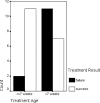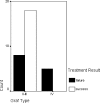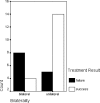Indicators of successful use of the Pavlik harness in infants with developmental dysplasia of the hip
- PMID: 16601983
- PMCID: PMC2267572
- DOI: 10.1007/s00264-006-0097-8
Indicators of successful use of the Pavlik harness in infants with developmental dysplasia of the hip
Abstract
This study examined the outcomes of ultrasound-monitored Pavlik harness treatment in 25 infants (2 boys and 23 girls) representing a total of 31 cases of developmental dysplasia of the hip of Graf type IIc or more severe. For all infants, Pavlik harness treatment started after ultrasonographic diagnosis in our clinic. If there was no improvement by the third week of follow-up, the harness treatment was discontinued. Of the 25 patients (31 hips), 16 patients (18 hips) were successfully treated with the Pavlik harness. The effects of age at start of treatment, gender, side of pathology, first clinical evaluation findings, bilaterality, and Graf type on Pavlik harness treatment success were analysed. We found that the outcome of treatment with the Pavlik harness was related to Graf type, age at start of treatment, and bilaterality.
Etude du traitement par harnais de Pavlik, avec contrôle par ultra-sons, de 31 dysplasies de hanche de type IIc ou plus selon Graf, chez 25 enfants (2 garçons et 23 filles). Dans tous les cas le traitement a débuté après un diagnostic ultrasonographique. En cas d’absence d’amélioration à la troisième semaine le traitement était arrêté. Sur les 25 patients, 16 (18 hanches) avaient un succés. Le rôle de l’âge au traitement, du sexe, du côté, de la première évaluation clinique, de la bilatéralité et du type selon Graf étaient étudiés. Nous avons constaté que l’efficacité du traitement par harnais de Pavlik dépend du type selon Graf, de l’âge au début du traitement et de la bilatéralité.
Figures





Similar articles
-
Success of Pavlik Harness Treatment Decreases in Patients ≥ 4 Months and in Ultrasonographically Dislocated Hips in Developmental Dysplasia of the Hip.Clin Orthop Relat Res. 2016 May;474(5):1146-52. doi: 10.1007/s11999-015-4388-5. Clin Orthop Relat Res. 2016. PMID: 26047647 Free PMC article.
-
Treatment of developmental dysplasia of the hip with Pavlik harness: prospective study in Graf type IIc or more severe hips.J Pediatr Orthop B. 2004 Mar;13(2):70-4. doi: 10.1097/01202412-200403000-00002. J Pediatr Orthop B. 2004. PMID: 15076582
-
Higher Pavlik Harness Treatment Failure Is Seen in Graf Type IV Ortolani-positive Hips in Males.Clin Orthop Relat Res. 2016 Aug;474(8):1847-54. doi: 10.1007/s11999-016-4776-5. Epub 2016 Mar 14. Clin Orthop Relat Res. 2016. PMID: 26975383 Free PMC article.
-
Comparison of outcomes of different Graf grades of developmental dysplasia of the hip in infants treated with Tubingen splint versus Pavlik harness - A systematic review.J Orthop. 2023 Nov 27;49:68-74. doi: 10.1016/j.jor.2023.11.060. eCollection 2024 Mar. J Orthop. 2023. PMID: 38075458 Free PMC article. Review.
-
[Pavlik's method in developmental dysplasia of the hip].Acta Orthop Traumatol Turc. 2007;41 Suppl 1:19-24. Acta Orthop Traumatol Turc. 2007. PMID: 17483619 Review. Turkish.
Cited by
-
What Risk Factors and Characteristics Are Associated With Late-presenting Dislocations of the Hip in Infants?Clin Orthop Relat Res. 2016 May;474(5):1131-7. doi: 10.1007/s11999-015-4668-0. Clin Orthop Relat Res. 2016. PMID: 26728512 Free PMC article.
-
The effect of the design of the orthosis on the axial load transmission of two flexion abduction orthoses used in treating congenital hip dysplasia.Heliyon. 2022 Dec 1;8(12):e11942. doi: 10.1016/j.heliyon.2022.e11942. eCollection 2022 Dec. Heliyon. 2022. PMID: 36478850 Free PMC article.
-
Treatment of developmental dysplasia of the hip with the Pavlik harness in children under six months of age: indications, results and failures.J Child Orthop. 2018 Aug 1;12(4):308-316. doi: 10.1302/1863-2548.12.180055. J Child Orthop. 2018. PMID: 30154920 Free PMC article.
-
[Treatment recommendations for protracted hip immaturity in infants : Conservative approach versus open reduction].Orthopade. 2018 Jun;47(6):539-552. doi: 10.1007/s00132-018-3579-7. Orthopade. 2018. PMID: 29808315 Review. German.
-
Clinical examination versus ultrasonography in detecting developmental dysplasia of the hip.Int Orthop. 2008 Jun;32(3):415-9. doi: 10.1007/s00264-007-0333-x. Epub 2007 Mar 1. Int Orthop. 2008. PMID: 17333184 Free PMC article.
References
-
- {'text': '', 'ref_index': 1, 'ids': [{'type': 'DOI', 'value': '10.1007/BF00436138', 'is_inner': False, 'url': 'https://doi.org/10.1007/bf00436138'}, {'type': 'PubMed', 'value': '6712426', 'is_inner': True, 'url': 'https://pubmed.ncbi.nlm.nih.gov/6712426/'}]}
- Graf R (1984) Classification of hip joint dysplasia by means of sonography. Arch Orthop Trauma Surg 102:248–255 - PubMed
-
- {'text': '', 'ref_index': 1, 'ids': [{'type': 'PubMed', 'value': '3335614', 'is_inner': True, 'url': 'https://pubmed.ncbi.nlm.nih.gov/3335614/'}]}
- Grill F, Bensehal H, Canadell J, Dungl P, Matasovic T, Vizkelety T (1988) The Pavlik harness in the treatment of congenital dislocating hip: report on a multicenter study of the European Paediatric Orthopaedic Society. J Pediatr Orthop 8:1–8 - PubMed
-
- {'text': '', 'ref_index': 1, 'ids': [{'type': 'DOI', 'value': '10.1097/00004694-199703000-00010', 'is_inner': False, 'url': 'https://doi.org/10.1097/00004694-199703000-00010'}, {'type': 'PubMed', 'value': '9075094', 'is_inner': True, 'url': 'https://pubmed.ncbi.nlm.nih.gov/9075094/'}]}
- Harding MG, Harcke HT, Boven JR, Guille JT, Glutting J (1997) Management of dislocated hips with the Pavlik harness treatment and ultrasound monitoring. J Pediatr Orthop 17:189–198 - PubMed
-
- {'text': '', 'ref_index': 1, 'ids': [{'type': 'PubMed', 'value': '1499221', 'is_inner': True, 'url': 'https://pubmed.ncbi.nlm.nih.gov/1499221/'}]}
- Harris IE, Dickens R, Menelaus MB (1992) Use of the Pavlik harness for hip displacements. When to abandon treatment. Clin Orthop 281:29–33 - PubMed
-
- {'text': '', 'ref_index': 1, 'ids': [{'type': 'DOI', 'value': '10.1097/00004694-200303000-00008', 'is_inner': False, 'url': 'https://doi.org/10.1097/00004694-200303000-00008'}, {'type': 'PubMed', 'value': '12604946', 'is_inner': True, 'url': 'https://pubmed.ncbi.nlm.nih.gov/12604946/'}]}
- Hedequist D, Kasser J, Emans J (2003) Use of an abduction brace for developmental dysplasia of the hip after failure of Pavlik harness use. J Pediatr Orthop 23:175–177 - PubMed
MeSH terms
LinkOut - more resources
Full Text Sources
Medical

